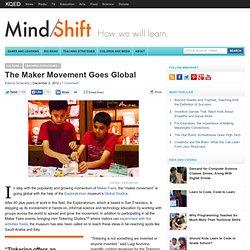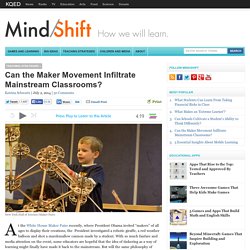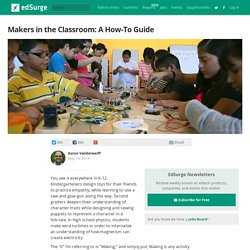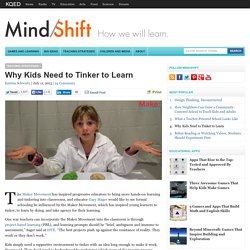

Maker-mindset.pdf. The Maker Movement Goes Global. Culture Teaching Strategies Courtesy: Exploratorium In step with the popularity and growing momentum of Maker Faire, the “maker movement” is going global with the help of the Exploratorium museum’s Global Studios.

After 40 plus years of work in this field, the Exploratorium, which is based in San Francisco, is stepping up its involvement in hands-on, informal science and technology education by working with groups across the world to spread and grow the movement. In addition to participating in all the Maker Faire events, bringing mini Tinkering Studios™ where visitors can experiment with the activities freely, the museum has also been called on to teach these ideas in far-reaching spots like Saudi Arabia and Italy.
“Tinkering offers an opportunity to decide for yourself what it is you are interested in learning” “Tinkering is not something we invented or anyone invented,” said Luigi Anzivino, scientific content developer for the Tinkering Studio in the museum. Related. Can the Maker Movement Infiltrate Mainstream Classrooms? New York Hall of Science/Maker Faire At the White House Maker Faire recently, where President Obama invited “makers” of all ages to display their creations, the President investigated a robotic giraffe, a red weather balloon and shot a marshmallow cannon made by a student.

With so much fanfare and media attention on the event, some educators are hopeful that the idea of tinkering as a way of learning might finally have made it back to the mainstream. Harvard Wants to Know: How Does the Act of Making Shape Kids’ Brains? Big Ideas Culture Design Thinking Teaching Strategies A group of Harvard researchers is teaming up with schools in Oakland, Calif. to explore how kids learn through making.

Through an initiative called Project Zero, they’re investigating the theory that kids learn best when they’re actively engaged in designing and creating projects to explore concepts. It’s closely aligned with the idea of design thinking and the Maker Movement that’s quickly taking shape in progressive education circles. Though it’s still in very early stages — just launched at the beginning of this school year — researchers and educators at the school want to know how kids learn by tinkering – fooling around with something until one understands how it works. They want to know what happens cognitively – how this learning process helps form habits of mind, builds character and how it affects the individual.
Makers in the Classroom: A How To Guide. You see it everywhere in K-12.

Kindergarteners design toys for their friends to practice empathy, while learning to use a saw and glue-gun along the way. Second graders deepen their understanding of character traits while designing and sewing puppets to represent a character in a folk-tale. In high school physics, students make wind turbines in order to internalize an understanding of how magnetism can create electricity. The “it” I’m referring to is “Making,” and simply put, Making is any activity where people create something, often with their hands. I often define Making by looking at what people bring to the Maker Faire, which does include more technical aspects like 3D printing, physical computing and programming. So what makes “Making” different from traditional classes? We have arrived at a time when many of the high-tech aspects of Making--such as physical computing or 3D design and manufacturing--are more readily accessible. So why use Making in K-12 schools?
What’s a Makerspace? Makerspaces come in all shapes and sizes.

They all serve as a gathering point for tools, projects, mentors and expertise. A collection of tools does not define a Makerspace. Rather, we define it by what it enables: making. A Makerspace is a learning environment rich with possibilities. As new hardware and software tools for making, digital design, and fabrication are emerging, we’re working together — with teachers and community leaders — to place those tools into the hands of a wider audience. We’re enabling new makers — and makers of makers — everywhere to create spaces, find the tools they need, and create the programs for the spaces.
Why Kids Need to Tinker to Learn. The Maker Movement has inspired progressive educators to bring more hands-on learning and tinkering into classrooms, and educator Gary Stager would like to see formal schooling be influenced by the Maker Movement, which has inspired young learners to tinker, to learn by doing, and take agency for their learning.

One way teachers can incorporate the Maker Movement into the classroom is through project-based learning (PBL), and learning prompts should be “brief, ambiguous and immune to assessment,” Sager said at ISTE. “The best projects push up against the resistance of reality. They work or they don’t work.” Kids simply need a supportive environment to tinker with an idea long enough to make it work, Stager said. They don’t need to be burdened by explaining which stage of the inquiry process they’re demonstrating.
[RELATED: Harvard Wants to Know: How Does Making Change Kids’ Brain?] To make his point, Stager gave the example of the wily Super Awesome Sylvia. Giving Kids a Chance to Make.